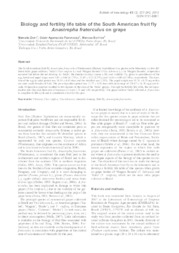Biology and fertility life table of the South American fruit fly Anastrepha fraterculus on grape.
Biology and fertility life table of the South American fruit fly Anastrepha fraterculus on grape.
Author(s): ZART, M.; FERNANDES, O. A.; BOTTON, M.
Summary: The South American fruit fly Anastrepha fraterculus (Wiedemann) (Diptera Tephritidae) was grown in the laboratory on two different table grape cultivars, ?Italia? (Vitis vinifera L.) and ?Niagara Rosada? (Vitis labrusca L.). In ?Niagara Rosada?, oviposition occurred but larvae did not develop. In ?Italia?, the duration in days (mean ± SE) and viability (%, given in parentheses) of the egg, larval and pupal stages were 3.01 ± 0.04 (61.75%), 21.95 ± 0.33 (8.25%) and 14.60 ± 0.09 (65.10%), respectively. The duration of the egg-to-adult period was 39.10 ± 0.45 days and the viability was 3.28%. The pupal weight was 15.10 ± 0.31 mg with a sex ratio (male:female) of 0.64. The pre-oviposition period was 11.77 ± 0.58 days with an average of 129.47 ± 16.38 eggs per female. Oviposition puncture resulted in two injuries to the skin of the ?Italia? grapes. Through the fertility life table, the net reproductive rate (Ro) and finite rate of increase (?) were 1.71 and 1.01, respectively. The grape cultivar ?Italia? allowed A. fraterculus to complete its life cycle and is considered a host for this pest.
Publication year: 2010
Types of publication: Journal article
Unit: Embrapa Grape & Wine
Keywords: Biologia, Dano, Fertilidade, Itália, Mosca-das-frutas, Niágara Rosada, Praga de planta, Uva, Uvas do Brasil, Viticultura
Observation
Some of Embrapa's publications are published as ePub files. To read them, use or download one of the following free software options to your computer or mobile device. Android: Google Play Books; IOS: iBooks; Windows and Linux: Calibre.
Access other publications
Access the Agricultural Research Database (BDPA) to consult Embrapa's full library collection and records.
Visit Embrapa Bookstore to purchase books and other publications sold by Embrapa.

